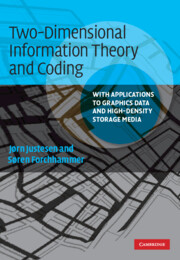 Two-Dimensional Information Theory and Coding
Two-Dimensional Information Theory and Coding Book contents
- Frontmatter
- Contents
- Preface
- 1 Introduction to information theory
- 2 Finite-state sources
- 3 Channels and linear codes
- 4 Reed–Solomon codes and their decoding
- 5 Source coding
- 6 Information in two-dimensional media
- 7 Constrained two-dimensional fields for storage
- 8 Reed–Solomon codes in applications
- Appendix A Fast arithmetic coding
- Appendix B Maximizing entropy
- Appendix C Decoding of Reed–Solomon code in F (16)
- Index
6 - Information in two-dimensional media
Published online by Cambridge University Press: 05 June 2012
- Frontmatter
- Contents
- Preface
- 1 Introduction to information theory
- 2 Finite-state sources
- 3 Channels and linear codes
- 4 Reed–Solomon codes and their decoding
- 5 Source coding
- 6 Information in two-dimensional media
- 7 Constrained two-dimensional fields for storage
- 8 Reed–Solomon codes in applications
- Appendix A Fast arithmetic coding
- Appendix B Maximizing entropy
- Appendix C Decoding of Reed–Solomon code in F (16)
- Index
Summary
Introduction
In the previous chapters we have presented the basic concepts of information theory, source coding, and channel coding. In Chapters 1−3 we have followed traditional information-theory terminology in distinguishing between sources, which produce information, and channels, which are used for transmission (or storage) of information. In many current forms of communication information passes through multiple steps of processing and assembly into composite structures. Since in such cases it can be difficult to make a distinction between sources and channels, we use the neutral term information medium to refer to structures, whether physical or conceptual, that are used for storing and delivering information. In short form the terms medium and media are used. The diverse forms of electronic media may serve as examples of the composite objects we have in mind and the range of meanings of the term. As a specific case one can think of a two-dimensional (2-D) barcode printed on an advertising display so that it can be read by a cell-phone camera and used as a way of accessing the website for the business.
In the case of highly structured composite objects we shall make no attempt to directly apply concepts like entropy or capacity. Instead we limit our applications of information theory tools to more well-defined components of such objects in digital form. The present chapter discusses how 2-D media can be described in the light of these concepts, and how the various tools can be used in such applications.
- Type
- Chapter
- Information
- Two-Dimensional Information Theory and CodingWith Applications to Graphics Data and High-Density Storage Media, pp. 86 - 118Publisher: Cambridge University PressPrint publication year: 2009
